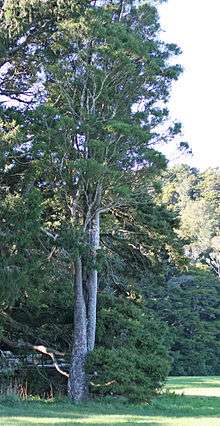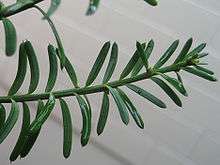Prumnopitys taxifolia
Prumnopitys taxifolia, the mataī (Māori: mataī) or black pine, is an endemic New Zealand coniferous tree that grows on the North Island and South Island. It also occurs on Stewart Island/Rakiura (47 °S) but is uncommon there.[2]
| Matai | |
|---|---|
 | |
| Scientific classification | |
| Kingdom: | Plantae |
| Clade: | Tracheophytes |
| Division: | Pinophyta |
| Class: | Pinopsida |
| Order: | Pinales |
| Family: | Podocarpaceae |
| Genus: | Prumnopitys |
| Species: | P. taxifolia |
| Binomial name | |
| Prumnopitys taxifolia | |
It grows up to 40 m high, with a trunk up to 2 m diameter. The leaves are linear to sickle-shaped, 10–15 mm long and 1.5–2 mm broad. The seed cones are highly modified, reduced to a central stem 3–4 cm long bearing 1-6 scales, each scale maturing berry-like, 10–15 mm long, violet-purple with a soft edible pulp covering the single seed. The seeds are dispersed by the New Zealand pigeon (kererū), which eats the 'berries' and passes the seeds in its droppings.
Classification
The scientific name taxifolia derives from the resemblance of the leaves to those of the yew (Taxus). In the past the species, like the other species of Prumnopitys, was often included in Podocarpus; in this species under the name Podocarpus spicatus. It is distinguished from Prumnopitys ferruginea (miro) by the shorter, more slender leaves and the globose violet-purple cones.
Juvenile state

Unlike the related miro (Prumnopitys ferruginea), matai has a distinctive and long-lasting juvenile stage. The juvenile is a shrub with a tangle of slender, flexible, divaricating branchlets interspersed with a scattering of brown, pale yellow, or dirty white leaves. After a number of years, the adult tree begins to grow out of the top of the juvenile shrub and then the divaricating branchlets will wither and drop off.[3][4]
Ecology
Matai are the host plant for caterpillars of the New Zealand endemic moth species Pyrgotis zygiana.[5] The seeds of this tree also play host to the another endemic moth Heterocrossa iophaea.[6][7]
Use

The timber of this tree was used extensively in New Zealand for flooring during the mid-20th century. Matai is not threatened,[8] although as a forest-type it has been greatly reduced through widespread logging. Very few intact examples of matai-dominated forest remain.
References
- Farjon, A. (2013). "Prumnopitys taxifolia". IUCN Red List of Threatened Species. 2013: e.T42541A2986139. doi:10.2305/IUCN.UK.2013-1.RLTS.T42541A2986139.en.
- Eagle, Audrey (2008). Eagle's complete trees and shrubs of New Zealand volume one. Wellington: Te Papa Press. p. 6. ISBN 9780909010089.
- "Prumnopitys taxifolia | New Zealand Plant Conservation Network". nzpcn.org.nz. Retrieved 15 January 2017.
- "Prumnopitys taxifolia (matai) description". www.conifers.org. Retrieved 15 January 2017.
- Dugdale, J. S. (1996). "Chrysorthenches new genus, conifer‐associated plutellid moths (Yponomeutoidea, Lepidoptera) in New Zealand and Australia". New Zealand Journal of Zoology. 23 (1): 57. doi:10.1080/03014223.1996.9518064.
- Burrows, Colin (1994). "Germinating matai seeds : an inadvertent experiment" (PDF). www.bts.nzpcn.org.nz. Retrieved 16 June 2018.
- Sullivan, Jon J.; Burrows, Colin J.; Dugdale, John S. (September 1995). "Insect predation of seeds of native New Zealand woody plants in some central South Island localities". New Zealand Journal of Botany. 33 (3): 355–364. doi:10.1080/0028825X.1995.10412962.
- IUCN (2011). "Prumnopitys taxifolia: Farjon, A." IUCN Red List of Threatened Species. 2011. doi:10.2305/iucn.uk.2013-1.rlts.t42541a2986139.en.
External links
| Wikimedia Commons has media related to Prumnopitys taxifolia. |
| Wikispecies has information related to Prumnopitys taxifolia |
